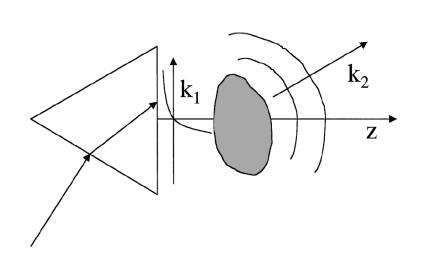Overview:
Total Internal Reflection
Tomography (TIRT) builds on Total Internal Reflection Microscopy (TIRM),
a technique that brings to conventional microscopy the added
functionality of illumination by evanescent waves. Incorporation of
evanescent waves in the illuminating field is an important development
for several reasons. First, such waves are exponentially decaying along
one direction. This property allows for the control of the depth of
penetration of the illuminating field. Second, an evanescent field may
be used to resonantly excite surface plasmon modes of the sample. Study
of these modes is important in understanding the behavior of material
interfaces. Third, evanescent waves may be employed to supersede the
Abbe-Rayleigh limit of order 1/2.
TIRM has been in practical use for
decades. It has primarily been used as a surface inspection technique,
though the sensitivity of the field to distance along the decay axis has
been utilized to advantage in applications such as the measurement of
distance between two surfaces . Until recently the opportunities for
transverse superresolution made possible by the high spatial frequency
content of the probe field have been largely over-looked. However, there
have been advances in the realization of super-resolved imaging
utilizing TIRM reported recently in the literature. A direct imaging
approach resulting from the marriage of standing-wave illumination
techniques and TIRM has been described achieving transverse resolution
of one seventh the wavelength. An additional approach has been brought
forward in which structural information derived from a scattering object
is extracted from the scattered field and a three dimensional
reconstruction of the object is made. The reconstruction is accomplished
by making use of an analytic solution to the inverse scattering problem
with evanescent waves . We refer to to the method as TIRT.
TIRT offers several advantages over
existing modalities for three-dimensional microscopy. First, the
evanescent waves used for illumination encode on the scattered field the
subwavelength structure of the scattering object. It is thus possible to
obtain subwavelength resolved images of the sample as is done in other
near-field techniques such as near-field scanning optical microscopy
(NSOM), without the technical difficulties encountered with probe-sample
interactions. Second, the results of the reconstruction are unambiguous.
That is, non-uniqueness associated with simultaneous variations in the
material optical properties and the topology of the sample is not an
issue. Third, the reconstruction obtained offers a three dimensional
view of the object. This is somewhat analogous to the transition from
projection radiography to computed tomography.

FIG. 1. Illustration of the
measurement scheme. Evanescent waves are generated at the prism face
by total internal reflection. The total internal reflection is then
partly frustrated by the presence of the scatterer, scattering evanescent
modes to the homogeneous mode that propagate to the far zone.
|
Current efforts:
In concjunction with researchers at
NASA Glenn Research Center, we are developing an experimental
implementation of TIRT. We continue to investigate the theoretical
aspects of the problem including analysis of the information content of
the near-field.
References:
- P S Carney and J C Schotland, "Three-Dimensional Total
Internal Reflection Microscopy," Opt. Lett. 26, 1072-1074 (2001). PDF
- P S Carney and J C Schotland, "Theory of
total-internal-reflection tomography," J. Opt. Soc. Am. A 20, 542-547
(2003). PDF
- R A Frazin, D G Fischer, and P S Carney, "Information
content of the near-field I: two-dimensional samples," Accepted by JOSA
A (2004). PDF
This project is being funded by a NASA grant.
See theFunding page for more details
|
